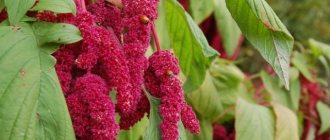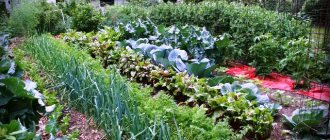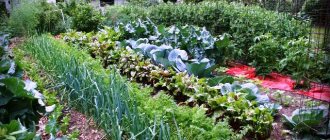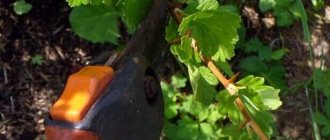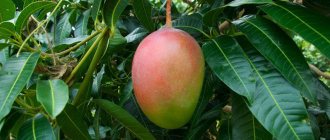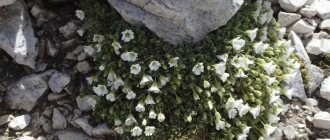Healthy, valuable, with a special texture, taste and aroma, asparagus is a favorite of gourmets and chefs. A delicacy that is very easy to grow yourself. This is a perennial vegetable that produces more and more shoots every year, capable of growing for decades and decorating the garden with its airy mass of special greenery. Asparagus requires minimal care and grows in almost any area, if you remember just a few important nuances and properly prepare the soil. Why do few of us take advantage of the opportunity to grow this valuable delicacy on our own?
Asparagus in the garden - the secrets of an excellent harvest
Where to plant asparagus
To choose the right place in your garden, you need to understand where and how wild asparagus grows in natural conditions.
The uncultivated asparagus plant, or asparagus, prefers warm, well-lit places near water. When choosing a place for beds, you need to be guided by the same principle.
Since asparagus in the garden can grow for one and a half to two decades without replanting, you need to approach the choice of location responsibly.
An area on the south side, well lit, protected from the wind, preferably isolated, is suitable for the beds.
Sandy and sandy loam soils well fertilized with humus are considered optimal for growth.
Which species are edible?
Representatives of the asparagus family can be found in wild and cultivated forms on all continents. They are common in the humid subtropical regions of South America, the arid steppes of Asia, Africa and Europe. In Russia, asparagus grows from the Krasnodar region to Siberia.
From the huge variety of species,
vegetable growers have selected plants that have a delicious taste and high nutritional value .
This is Asparagus officialis or Asparagus officinalis. Based on it, breeders have developed hybrids that produce abundant harvests. Asparagus is valued not only for its exquisite taste, but also for its medicinal dietary properties. Its shoots contain asparagine, phytohormones and a unique vitamin complex.
In ancient times, this plant was credited with many miraculous properties, ranging from improving eloquence to gaining immortality. Read more about signs and superstitions associated with asparagus here. Nowadays, the positive effect of asparagus on the body has been experimentally proven : human reproductive function, the state of the nervous system and increased tone.
Important! Only young shoots are edible and tasty. Berries are poisonous!
Planting asparagus
Depending on the species, not only the sowing time, but also the methods differ.
For example, purple asparagus Mary Washington is a mid-early variety, perfectly adapted to growing in our conditions.
White Tsarskaya asparagus is a mid-season variety that is not afraid of drought, frost and is generally very unpretentious.
The Slava Braunschweig variety is suitable for canning and is considered a late variety.
To obtain the desired harvest, you need to obtain information in advance about how to grow seedlings, how to plant asparagus in open ground, and what care is needed afterwards.
Spring planting
Planting of divided bushes or cuttings of asparagus is done in the spring, before the buds awaken. This method is more popular, since growing asparagus from seeds is much more difficult.
In addition, it will reach the table only in the third year after collecting the seeds. Vegetative propagation will allow you to harvest earlier.
To plant a rhizome divided into parts, you need to cultivate the area in the fall: remove plant debris and weeds, dig well and fertilize the soil. In addition, for each m2 you need to add 6-8 kg of humus.
In the spring, asparagus, whose root resembles a giant spider, is ready to plant. In the garden bed you need to dig a trench, the depth of which is 30 cm and the width is 20.
Despite the fact that rhizomes at this stage take up little space, the distance between adjacent plantings should be at least 30 cm, and the row spacing should be 1.5-2 m.
Asparagus grows a lot and care must be taken to ensure that the bushes do not interfere with each other in the future.
A layer of compost is laid at the bottom of the trench, then soil is added in a mound, asparagus is planted on it and sprinkled with the rest of the soil. Plantings are mulched with sawdust, straw, and leaves.
Growing asparagus this way is not difficult.
Autumn planting
Asparagus is not the most popular vegetable in Russia, but it winters well if planted in the fall.
In October, mineral fertilizers are applied to the soil - 30 g each of superphosphate and potassium salt, after which asparagus is planted.
The distances between plants are the same as for spring planting. The only difference is that the roots are not deeply buried, and a mound of soil is placed above each bush, protecting the roots from frost.
Diseases and pests
Asparagus is considered a hardy plant that is rarely affected by diseases and pests. But there are specific diseases that can quickly ruin plantings and deprive them of the long-awaited harvest.
Diseases and control measures
Root rot, or fusarium. The disease affects the roots and root collar. As a result, the entire bush suffers - branches begin to crumble and soon the plant dies. Fundazol helps in the initial stage of the disease. If the disease is advanced, you will have to dig up and destroy the entire bush.
Damage to the root system leads to the death of the entire plant
Rust. In June, affected asparagus shoots become dark in color. The areas affected by the disease increase in size - this is where spores ripen, which will then move to healthy leaves. Rust takes over the asparagus bed gradually. Therefore, carefully inspect the plantings so that if the first signs are detected, use fungicides to combat the fungus.
The appearance of spots on asparagus stalks is a sure sign of rust.
Pests
Asparagus fly. From mid-May to the end of June, the fly lays eggs inside asparagus shoots. After a week, larvae appear and begin to eat away the core of the shoot. As a result, the stem becomes bent and then breaks and dries out. To combat flies, insecticides are used, for example, Actellik.
Asparagus fly larvae eat asparagus stems from the inside
Asparagus rattle. The beetle and its larva eat stems, foliage, and berries. The plant first stops growing and then dries out completely. To combat the pest, the soil in asparagus plantings is treated with Actellik solution. The beetles are collected by hand.
This beautiful beetle is a dangerous enemy for asparagus
Prevention and treatment
Most often, asparagus suffers from diseases and pests as a result of improper care.
- do not plant asparagus on heavy soils;
- before planting, bring the acidity level to normal levels - pH 6 - 7;
- inspect the plantings every week to identify the first signs of diseases and pests;
- do not leave remnants of roots and stems between the rows;
- do not overwater asparagus, this leads to root diseases;
- if marigolds, calendula, basil or cherry tomato bushes are planted around the perimeter of the asparagus bed, the number of pests will be significantly reduced;
- In the fall, you need to cut off all the drying asparagus shoots and burn them.
In autumn and early spring, asparagus beds should be treated with fungicides - Topaz, Fitosporin. Gardeners are especially fond of Bordeaux mixture.
Prevention is the best way to protect plants from diseases and pests
Growing asparagus from seeds
Growing asparagus from seeds is possible by germinating them to seedlings and then replanting them in a garden bed, or by planting asparagus seeds in open ground.
How to collect asparagus seeds
To grow young plants, seeds can be purchased at a specialized store or collected yourself if you already have bushes, but want to expand the plantation.
From an adult asparagus bush, at 3-4 years of age, seeds are collected as follows.
- By mid-October the bush is covered with red berries. You shouldn't eat them, however, they are not only decorative. Each berry contains seeds, which are used to sow asparagus.
- Collect ripe berries, grind the pulp and spread on gauze folded in two layers.
- When the pulp dries, the berries will easily separate from it. They need to be washed in warm water and dried again.
- Before planting, asparagus seeds are stored in linen or paper bags in a cool, dry place.
Growing asparagus seedlings
- Before planting, the seeds should be soaked in warm water for two to three days to facilitate germination. The water needs to be changed daily. You can add a drug that accelerates germination. For example, Zircon, Epin or hydrogen peroxide.
- Fold gauze or other fabric in several layers. Then moisten it well and place the seeds on it. Cover the top with a damp cloth. It is important to ensure that the fabric does not dry out. Place the seeds in a warm place. Leave until they begin to grow.
- Sprouted seeds can be planted in cups or directly in a prepared bed. Soil composition: garden soil, peat and humus in equal proportions. You can add a little sand, wood ash, perlite.
- When planting in a garden bed, the soil is fertilized with humus or manure, dug well, loosened and moistened.
- Seeds are planted in early May, densely, every 5-7 cm from each other. After the shoots appear, picking will be required. The strongest ones are left (the distance between seedlings is doubled).
How to grow asparagus without sprouting (from seeds)
- Soak the seeds in warm water for a week, changing the water daily.
- Prepare the seedling bed.
- Plant the swollen seeds and wait for sprouts to appear.
Growing asparagus from seeds by obtaining seedlings is a faster and more productive process, but everyone is free to choose for themselves.
The asparagus sprouts will spend several seasons on the seedling bed until they finally get stronger and gain strength, and then they need to be transplanted to a permanent place.
During this period, planted seeds require proper care. It is necessary to loosen the soil, hill up the emerging shoots, regularly water and feed. In June, nitrogen is needed, and in August, in preparation for wintering, potassium and phosphorus are needed.
To prevent frost from damaging the rhizome, at the end of October, after the green ground part of the plant has died, asparagus is mulched with a layer of peat or humus. You can cover the plantings with spruce branches and dry leaves.
Room representatives
Indoor types of asparagus take root well at home . Such plants can grow in deep pots, wide bowls on windowsills. They are mainly installed next to windows or in bright, spacious loggias.
The soil for such plants is chosen to be neutral or slightly acidic. Fertilizers are applied along with watering. Watering is carried out as the top layer of soil dries. As for the diseases to which asparagus is susceptible and pests, detailed information can be found here.
The main indoor subspecies include:
Meyer's asparagus (Asparagus meyeri) is a variety of asparagus that is a small shrub. Grows throughout Asia. It reaches a height of no more than 40-50 cm. It has a branched structure, growing up to 6 m in width. The side shoots are cladodes. Due to the convenient location of the ovaries, this representative of the flora was nicknamed the “fox tail”.
Asparagus plumosus is an evergreen perennial. It has graceful curly branches. The leaves look like miniature scales. The stems are curved and are phylloclades growing in the form of bunches. The flowers are miniature, snow-white. After flowering, blue-black fruits are formed.
Crescent asparagus (Asparagus falcatus) is a vine or subshrub with climbing stems. With good care, it reaches a height of 5-7 m. It has woody branches with small thorns in the form of hooks. With their help, the plant clings to supports and climbs towards sunlight. This representative of the flora grows in the mountainous areas of Asia.
Sprenger's asparagus (AsparagusdensiflorusSprengeri) is a subshrub with branched stems. It reaches a height of 40-50 cm. The shoots of the plant are elongated, reaching 1.5 m. They form narrow-lanceolate cladodes of an emerald hue. The leaves are miniature and scaly. The plant blooms with miniature snow-white flowers collected in paniculate inflorescences. After flowering, oval fruits of a burgundy hue are formed.
Reproduction by dividing the bush
Asparagus can be replanted at any time of the year. However, it is most convenient to do it in the spring, before the ground part has grown quite strongly.
It is rational to transplant asparagus in the fall from mid to late October, so that the rhizomes have time to adapt to the new location before frost sets in.
Young plants are replanted annually; after 3-5 years, you can leave the asparagus alone and change the location every 10-15 years.
To divide the bush, the soil around it is well moistened, then the plant is dug out along with a lump of earth.
The soil is carefully removed and divided into parts with a sharp knife so that each has at least one strong sprout. Each part is rooted into the soil as an independent plant, at a distance of 30-40 cm from each other.
Asparagus – photo
Asparagus in a room or in a garden is primarily a spectacular ornamental plant. In our latitudes, many people do not know about it and, as a result, underestimate it. Completely in vain!
Photo: no.pinterest.com
Photo: commons.m.wikimedia.org
Photo: dev-gardenstylesanantonio.com
Photo: 2sotki.ru
Photo: doflowers.ru
Photo: fruitree.ru
Photo: zumipic.com
Photo: serissa.ru
Photo: pinwc.com
Photo: vita-animal.ru
Photo: ecobeltex.ru
Photo: datchnik.ru
Photo: whatflower.ru
Photo: mirata.lt
Photo: pulse.mail.ru
Photo: pinterest.fr
Photo: o-remonte.com
Photo: domashniecvety.ru
Photo: sunhome.ru
Photo: agronom-world.ru
Photo: domashniecvety.ru
Photo: 1poin.com
Dracaena (70 photos): types and features of care
Propagation by cuttings
Another popular method of vegetative propagation is cuttings. On mature plants, sprouts appear in early spring. Asparagus grows quite quickly, so you can take cuttings as early as April.
Strong young shoots are cut, divided into parts with a sharp knife (so that each has 2-3 buds) and rooted in cups with prepared soil mixture or sand.
To create comfortable conditions, the cuttings are covered with a jar on top. It is necessary to create conditions for the cuttings to take root: air temperature 20-250C, regular watering and spraying. Asparagus takes root quite easily at home; in June it can be planted in open ground under a film.
Species variability
Among all the diversity, Sprenger's asparagus has taken root in our culture the most, with characteristically curving light green branches and thorn-like leaves covering them. The white flowers are completely inconspicuous, but have a pleasant scent.
The Meyer variety, the most popular for growing in the garden, resembles a spindle, and Chamois has strong, woody shoots over time, densely covered with cladodes, and is often used in flower arrangements.
Very famous are Asparagus-like asparagus with creeping one and a half meter shoots, also used in bouquets, as well as Umbrella - a plant with aerial shoots on which cladodes are arranged in bunches.
Forcing asparagus in winter
Proper agricultural technology allows you to get young asparagus sprouts in winter. To do this in the fall, after harvesting, you need to cut off the ground shoots. And underground ones - dig them up and put them in a basement or cellar. Storage temperature is about 0º.
At the beginning of December, prepare containers with soil, plant rhizomes in them, close to each other, sprinkle with a layer of humus (15-20 cm) and cover with thick black film.
Place the containers in the greenhouse. For approximately 7-10 days, the air temperature is maintained at +10ºС, then increased to +18-20ºС. In two months the first harvest will be on the table.
Asparagus care
Proper planting and timely care are the key to a good asparagus harvest. The plant cannot be called whimsical, but a certain amount of work will still need to be invested.
Watering
Asparagus tolerates drought well, but water that stagnates in the garden can seriously damage it. Therefore, when watering, it is important not to overdo it. It is advisable not to allow the soil to dry out, but it is better to underwater than overwater.
After watering, it is advisable to loosen the soil and hill up the sprouts. It is not necessary to do this every time (especially in hot, dry weather when daily watering is required), but 2-3 times a month will not hurt at all.
Top dressing
Another component of garden care: fertilizing. How asparagus grows and looks, how it feels in the garden, what kind of harvest it will yield, largely depends on the fertilizers applied:
- in the spring, before planting asparagus, add manure or humus (10 kg/m2) to the soil;
- if planting is carried out in the fall, then superphosphate (60 g/m2), potassium sulfate (30 g/m2), ammonium sulfate (20 g/m2) must be added to the soil;
- 3-4 weeks after planting, water the soil with mullein solution (1:5);
- at the end of June, mineral fertilizers are applied again (30 g/m2) - superphosphate, potassium sulfate, urea;
- at the end of July, organic matter is added again (mullein, manure, bird droppings);
- In the fall, the season is completed by applying mineral fertilizers (superphosphate, potassium salt).
Before wintering, the above-ground part is cut off and the rhizomes are sprinkled with a layer of peat and leaves.
Are there any differences in name between ornamental and vegetable crops?
Asparagus is the Latin word scientists use for asparagus. Therefore, contrary to popular belief, we can confidently say that every asparagus is asparagus, and every asparagus is asparagus , that is, they are one and the same.
As a vegetable, this crop came to Russia from Germany. The German word “spargel” turned into “asparagus” and was even mentioned in Dahl’s explanatory dictionary. It contains terms such as asparagus, asparagus and asparagus grower.
Fans of indoor floriculture and florists traditionally call it asparagus, and farmers and cooks call it asparagus.
Harvesting
The yield of asparagus depends on the correct cultivation of the crop and the timely application of fertilizing.
Asparagus harvesting begins in late April-early May. As soon as it becomes noticeable that the underground shoots are ready to “climb to the surface” (the soil cracks and rises), it’s time to cut them off. To do this, you need to rake out the layer of soil and carefully, trying not to damage the rhizome, cut off the seedlings with a sharp knife.
The plant begins to bear fruit only at 3-4 years of age. In the first harvest season, harvesting should not last 3-4 weeks, so as not to deplete the asparagus. Sprouts are collected from mature plants before the end of June.
It is important to understand that only the underground parts of the stems are considered edible; on the surface they darken and are not recommended for consumption.
Since growth becomes more rapid with increasing temperature and day length, harvesting can be done twice a day. This should be done in the early morning and evening, closer to sunset.
The shoots left for further growth scatter lacy greenery and become part of the decor. For this purpose, they are used in landscape design.
The berries that ripen on them are also inedible and are only suitable for collecting seeds.
Asparagus varieties
Before you grow asparagus at home, you need to decide on the variety. There are quite a lot of them, they differ in appearance, care conditions and taste.
Paying attention to recommendations on how to grow asparagus at home, you need to correlate the requirements of the variety (drought resistance, frost resistance, heat tolerance) with the actual growing conditions.
In addition, there are varieties that are not eaten, but are used as medicine or for decorative purposes in the countryside. Although not everyone knows how asparagus blooms, its flowers are small and completely inconspicuous, but the red berries on openwork green branches look very beautiful.
Variety Snow Head
This is a variety that is suitable for growing asparagus both in the Moscow region and in hotter, arid regions.
The variety is considered mid-early; the shoots are pale green in color and end with a delicate, loose, light-colored head. The taste is comparable to young green peas.
Variety Slava Braunschweig
The opposite of Snowhead, Brunswick's Glory ripens late, in mid-autumn. The shoots are pale milky in color and are most often used for canning for the winter.
Variety Arzhentelskaya
Somewhere between the two previous varieties is Argentelian asparagus, which may look similar to Slava Braunschweig, but its shoots are larger, moreover, the collection can be continued from spring to mid-autumn, respectively, both eaten fresh and stored for the winter .
It is widely believed that green beans, called asparagus beans, are also related to asparagus. However, they should not be confused; they are completely different species.
Description of the plant
Asparagus (Asparagus) is a perennial plant . Previously, this representative of the flora belonged to the Liliaceae family. But, at the moment, asparagus crops are classified as a separate family. Therefore, Asparagus now belongs to the Asparagaceae family.
It grows actively in Europe, Siberia, the Caucasus, China, Australia, the USA, and on the Mediterranean coast. It can be a spreading subshrub, emerald grass or vine. The branches of Asparagus reach a height of more than 150 cm. They are endowed with small flattened branches with bunch-shaped cladodes.
Cladodes are located on stems and scale-like leaves. The leaves are miniature, underdeveloped or completely absent. There are hard spurs on the trunk. The plant has a well-developed root system.
